Shin Hanga prints
| Design: | Okada Yoshio (1934-2021) | |||||
| Title: | Akashi | |||||
| Series title: | Genji emaki (Picture scroll of Genji) | |||||
| Size: | 33.9 x 28.5 cm (ōban) | |||||
| Original woodblock print | ||||||
| Photography: | Jacques Commandeur |
|
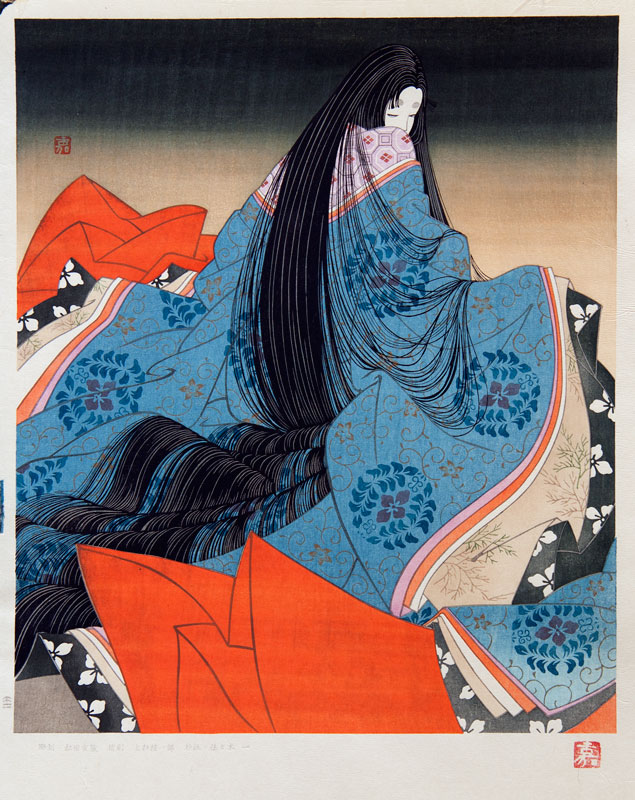
|
Special effects: subtle gold mica in the patterns of the kimono.
During my visit to Japan in May 2017 printmaker David Bull invited me to join him on a one day trip to his home in Ome together with Toshikazu Doi-san and John Amoss. I was of course delighted to accept his invitation. In Ome he showed us a selection of the Japanese woodblock prints and books in his private collection. Among those were the other three prints in the Picture scroll of Genji series designed by Okada Yoshio (Dave’s copy of the Matsukaze print was unfortunately quite heavily foxed but his copies of the other two prints were in perfect condition), so I took the opportunity to take the following pictures of Dave’s copies of these other three beautiful prints in the series (click to enlarge):
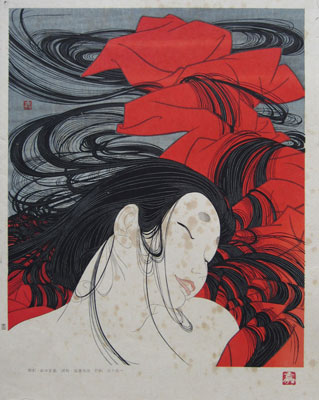
|
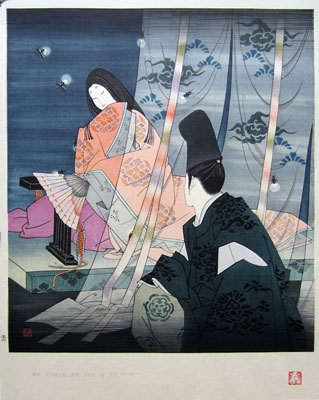
|
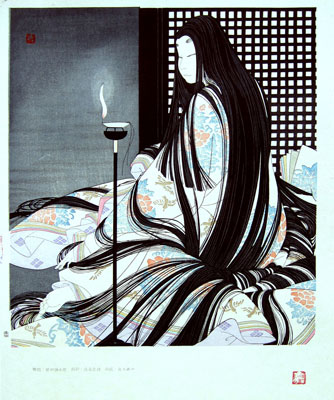
|
| Matsukaze | Hotaru | Wakana |
Even better was that it transpired that David had acquired all the blocks for the making of this series of prints as a gift from Yoshio Okada himself. I had the great privilege that day in Ome of being allowed to uncover and open up the stack of blocks used in the making of the Akashi print for the very first time since David acquired these blocks. Here are some of the photos I made along the way (click to enlarge):
.jpg)
|
.jpg)
|
.jpg)
|
| The stack of blocks after I cut the ropes with a copy of the Akashi print on top |
The key block | The block for the gold mica pattern on the kimono and the red Yoshi seal |
.jpg)
|
.jpg)
|
.jpg)
|
| The block for the light blue colour on the kimono |
The block for the black hair | The second block for the black hair |
Published by Yūyūdō in 1978 or 1979.
Red seal reading Yoshi in upper left area and bottom right margin of the print.
Names of the carver, printer, and paper maker in bottom margin of the print:
| Character | Reading | Meaning | Translation |
| 彫 | chō | carve | |
| 刻 | koku | engrave | Carver: |
| 松 | matsu | pine | |
| 田 | ta | rice field | |
| 寅 | tora | sign of the tiger | |
| 蔵 | zō | storehouse | Matsuda Torazō |
| 摺 | su(ru) | rub | |
| 刷 | satsu | Printer: | |
| 上 | ue | upper | |
| 杉 | sugi | Japanese cedar | |
| 桂 | kei | Japanese Judas-tree | |
| 一 | ichi | one | |
| 郎 | rō | husband | Uesugi Keiichirō |
| 抄 | shō | extract | |
| 紙 | shi | paper | Paper maker: |
| 佐 | sa | assistant | |
| 々 | sa | ||
| 木 | ki | wood | |
| 一 | hajime | one | Sasaki Hajime |
Yūyūdō publisher seal in lower left margin of the print.
The protective folder has the label:

|
in which the kanji 明石 read Akashi.
The direct inspiration for the Akashi woodblock print was the following Okada Yoshio illustration issued in the Shūkan Asahi magazine (click to enlarge):
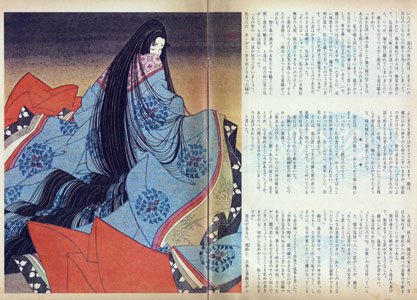
|
The latter illustration was again based on this water colour painting of Okada Yoshio (click to enlarge):

|
which can be found on pages 56-57 of this book.
There are several people in the Tale of Genji called Akashi. Then, there is also a Japanese village called Akashi. The full name of the woman shown in this print of the Genji emaki set is actually Akashi no Kimi, also known as Akashi no Ue. Here she is depicted when still living in Akashi and after meeting Genji for the first time.
With the kind help of David Bull, in September 2018 I was able to obtain original copies of the other three prints in the Genji emaki series as well: Hotaru, Wakane, and Matsukaze.
References
- David Bull’s YouTube video Beginnings part 1 issued in August 2018.
- Eric van den Ing’s Saru Gallery website here.
- The Mokuhankan collection here.
Provenance: Mokuhankan


